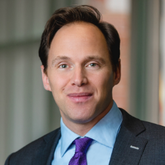An Interview with Edo Banach: The Longer Horizon
This blog post is part of a five-part series in which Diane E. Meier, MD, interviews the inspiring keynote speakers of CAPC National Seminar 2018.
In this post, Dr. Meier is joined by Edo Banach, JD, President & CEO of the National Hospice and Palliative Care Organization (NHPCO). This interview provides a sneak peek into their joint keynote, “Now is the Time: Uniting to Transform Health Care.”
Dr. Diane E. Meier (DEM): Thank you for agreeing to be a plenary speaker at the upcoming CAPC National Seminar. As you know, the goal of the Seminar is to help position leaders in the field in the national context, to understand where we fit and what we can do to help drive the health care system in the right transformational direction.
In our joint plenary, we will discuss the need for new styles of leadership to tackle challenges, and the call for creative and collaborative partnerships to ensure quality of care, avoid redundancy, and improve efficiency. On that note, why do you think partnerships are essential to ensuring access and quality?
Edo Banach (EB): Partnerships are an important aspect of everything that we do, especially when we’re trying to make sure that people living with serious illness have more person-centered care provided by an interdisciplinary team. The nature of this kind of care demands that the different disciplines and perspectives—whether payer, provider, or professional—interact and coordinate another to ensure the best care. Hospice can’t do this alone. The palliative care specialists can’t do this alone. I don’t think any single individual or discipline will have a monopoly on the best ideas, so collaboration is key.
Partnerships are an important aspect of everything that we do, especially when we’re trying to make sure that people living with serious illness have more person-centered care provided by an interdisciplinary team.
DEM: I strongly agree with that. The National Coalition for Hospice and Palliative Care is an exemplar of the importance of that type of communication, collaboration, and partnership so that the field—to the extent possible—speaks with one voice. We need to help steer the ship of state, the health care system, in a direction that best serves the needs of our patient population; this is an opportunity for highlighting the importance of the coalition.
We need to help steer the ship of state, the health care system, in a direction that best serves the needs of our patient population.
To put a finer emphasis on why partnership is also a financial necessity, and that the need for community-based palliative care is virtually infinite in the United States, just think of the number of people who end up calling 911, or are in a hospital Emergency Department when a well-coordinated and resourced palliative care program could have managed their care in their homes and communities. There is no way to begin addressing that need without all hands on deck, including everyone who is skilled at taking care of complex and seriously ill people, first among them hospice professionals. Why are partnerships therefore defined as a financial necessity?
EB: To provide a simple answer, there is usually no clear-cut palliative care payment model to support the team. Unfortunately, without a managed payer, an ACO, or even a health system determining that it is beneficial to pay for community-based palliative care, the hospice or stand-alone palliative care program doesn’t have a stream of payment to support the program. In order to meet our patient’s multidimensional physical, emotional, financial, spiritual, and practical needs across the longitudinal course of a serious illness, all of us must pull together, communicate, and coordinate far better than we are doing now.
All of us must pull together, communicate, and coordinate far better than we are doing now.
For a more complicated answer, the necessity to stand together and stand for real quality is due to the need to survive in an increasingly crowded world, where the provision of this care not only comes from the traditional health care sector, but increasingly from app developers, vendors, technical “fixes”, and others claiming to have an impact on care for our patient population at a lower price. Whether we’re talking about Amazon, Walmart, or anyone else, there are a lot of other people interested in this space. Where there is money to be saved, there is money to be made.
DEM: All that we have to do to underline your point is to point to the rapid expansion of the multi-state vendors delivering community-based palliative care under contract with risk-bearing entities—especially with Medicare Advantage plans—completely outside of the traditional mainstream healthcare system.
EB: Agreed, and I would argue that we should partner with everyone who is trying to identify and meet the needs of this rapidly expanding high need patient population. We have to figure out how we can work together collaboratively, because the patient need is growing exponentially.
DEM: I completely agree. If you were advising the leaders of the hospices and palliative care programs that are members of NHPCO and CAPC, what can they do on a practical level to prepare themselves, their organizations, and their communities for this inevitable move from fee-for-service towards value, meaning that everyone will be accepting some financial risk?
EB: Well, one answer is to just start doing it. Even if this is a losing proposition for a few years, at some point it will change. Long term, the real losing proposition is to not take action, and for those who don’t have a horizon longer than just a few years from now, it’s important to look to someone who does. Experimenting and putting yourself in a position where you understand how to manage risk helps you understand what it takes to be successful; do this by partnering with others who can help you, and show your value to those who are paying for it, whether the government, the health plan, your health system, the ACO, whomever. This is an issue we’ve had at times with large sophisticated hospices. Don’t rest on your laurels and think that what works today will be there tomorrow; it’s important in any sector and industry to continue to evolve.
Don’t rest on your laurels and think that what works today will be there tomorrow; it’s important in any sector and industry to continue to evolve.
DEM: It’s fascinating that you say that if you don’t see yourself leading through to that longer horizon, find someone who will. I recently attended a two-day meeting with the Leavitt Partners and their advisors. They said that a substantial subset of CEOs of health systems across the country are now saying, “I’m going to retire before this hits. I’m just going to keep the rudder straight, making my margin under fee-for-service. I won’t have to deal with this; the next person will.” This is the risk with senior leaders. It’s asking them to fundamentally disrupt what they’ve done their whole lives, as well as disrupt their organization in an era of profound uncertainty about what’s going to come. And yet that’s what we’re asking people to do.
EB: Indeed, and I feel like I have a responsibility, as someone in my forties, since my horizon is longer. I think everyone’s horizon needs to be longer. It’s not personal—it’s about stewardship of the precious resource, the people, working in our health care system. Preparing the workforce for the future is an essential function of leadership.
DEM: Yes, I think that’s a powerful and important message to both the CAPC and NHPCO audiences. We have one perspective as leaders, but the people on the front lines doing the real work, who are providing day to day care and struggling in local communities that are all different, all have very specific and unique challenges. What are you hearing from NHPCO members that you would identify as common themes about this issue?
EB: In the field, there is a lot of confusion about what palliative care is, what hospice is, and how the two intersect. With that comes frustration for a provider that offers both services, as many of our members do. Additionally, despite talk of hope and change, the thing that still pays the best right now is the status quo. So how do we actually move towards the new world that you’re talking about, where reimbursement is available to help pay for the employees, technology, and everything else that’s needed to provide palliative care under these new models, when we’re still being paid out of the old models? That’s a real source of frustration, for both large and small members.
In the field, there is a lot of confusion about what palliative care is, what hospice is, and how the two intersect.
DEM: Would you say that you’re observing a trend towards hospices delivering palliative care outside of the Medicare Hospice Benefit?
EB: Yes, it’s like the ‘uncertainty principle’. By observing it, we’re making it happen. Part of my mandate is to help shed a light on the necessity to change our perspective, to provide great hospice care today, and have an eye on what it means to provide person-centered interdisciplinary care tomorrow with or without the Medicare Hospice Benefit. Most of our members are ready, and are either already heading in that direction, or desire to.

